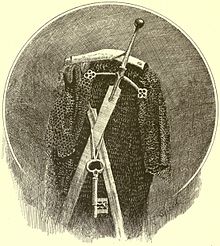| Claymore | |
|---|---|
 16th century claymore in the National Museum of Scotland. | |
| Type | Two-handed sword |
| Place of origin | |
| Service history | |
| In service | c. 1400–1700 |
| Used by | Highland Scots |
| Specifications | |
| Mass | ≈2.2–2.8 kg (4.9–6.2 lb)[citation needed] |
| Length | ≈120–140 cm (47–55 in)[citation needed] |
| Blade length | ≈100–120 cm (39–47 in)[citation needed] |
| Blade type | Double-edged |
| Hilt type | Two-handed cruciform, with pommel |

A claymore (/ˈkleɪmɔːr/; from Scottish Gaelic: claidheamh-mòr, "great sword")[1] is either the Scottish variant of the late medieval two-handed sword or the Scottish variant of the basket-hilted sword. The former is characterised as having a cross hilt of forward-sloping quillons with quatrefoil terminations and was in use from the 15th to 17th centuries.
The word claymore was first used in reference to basket-hilted swords during the 18th century in Scotland and parts of England.[2] This description was maybe not used during the 17th century, when basket-hilted swords were the primary military swords across Europe, but these basket-hilted, broad-bladed swords remained in service with officers of Scottish regiments into the 21st century. After the Acts of Union in 1707 (when Scottish and English regiments were integrated together), the swords were seen as a mark of distinction by Scottish officers over the more slender sabres used by their English contemporaries: a symbol of physical strength and prowess, and a link to the historic Highland way of life.
- ^ "claymore". Oxford English Dictionary, 2nd ed., 1989. [1] (subscription required)
- ^ Blair, Claude (1981). The Word Claymore. Edinburgh: John Donald Publishers. p. 378.